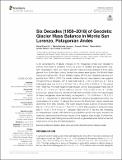Files in this item
Six decades (1958–2018) of geodetic glacier mass balance in Monte San Lorenzo, Patagonian Andes
Item metadata
| dc.contributor.author | Falaschi, Daniel | |
| dc.contributor.author | Lenzano, María Gabriela | |
| dc.contributor.author | Villalba, Ricardo | |
| dc.contributor.author | Bolch, Tobias | |
| dc.contributor.author | Rivera, Andrés | |
| dc.contributor.author | Lo Vecchio, Andrés | |
| dc.date.accessioned | 2019-12-16T16:30:03Z | |
| dc.date.available | 2019-12-16T16:30:03Z | |
| dc.date.issued | 2019-12-11 | |
| dc.identifier | 264471744 | |
| dc.identifier | eeec881b-822c-4b41-bddf-e1be0ad6eeb2 | |
| dc.identifier | 85077251628 | |
| dc.identifier | 000504216200001 | |
| dc.identifier.citation | Falaschi , D , Lenzano , M G , Villalba , R , Bolch , T , Rivera , A & Lo Vecchio , A 2019 , ' Six decades (1958–2018) of geodetic glacier mass balance in Monte San Lorenzo, Patagonian Andes ' , Frontiers in Earth Science , vol. 7 , 326 . https://doi.org/10.3389/feart.2019.00326 | en |
| dc.identifier.issn | 2296-6463 | |
| dc.identifier.other | RIS: urn:BEC94A0F3CF828F6C3D41F9449E0FBCD | |
| dc.identifier.other | ORCID: /0000-0002-8201-5059/work/66398494 | |
| dc.identifier.uri | https://hdl.handle.net/10023/19140 | |
| dc.description | This research was funded by the Agencia Nacional de Promoción Científica y Técnica (Grants PICT 2007-0379 and PICT 2016-1282). RV was partially supported by the Foundation BNP-Paribas through THEMES project. AR acknowledges FONDECYT 1171832 and CECs. | en |
| dc.description.abstract | A full understanding of glacier changes in the Patagonian Andes over decadal to century time-scales is presently limited by a lack of detailed and appropriate long-term observations. Here, we present geodetic mass and area changes of three valley glaciers from Monte San Lorenzo derived from stereo aerial photos, the Shuttle Radar Topography Mission (SRTM) and satellite imagery (SPOT5 and Pleiades) spanning four periods from 1958 to 2018. Our results indicate that net mass balance was negative throughout the six decades, with a mean mass loss of −1.35 ± 0.08 m w.e. a–1 and a total glacier area loss of 14.2 ± 0.7 km2 (23 ± 1% or 0.40 ± 0.02% a–1). The period 1981–2000 had the most negative mass budget, with an area-averaged mass loss of 1.67 ± 0.11 m w.e. a–1 and a maximum loss of −2.23 ± 0.07 m w.e. a–1 at San Lorenzo Sur glacier. Over the periods of 2000–2012 and 2012–2018, the mass budget of these three glaciers remained virtually unchanged at −1.37 ± 0.06 and −1.36 ± 0.17 m w.e. a–1, respectively. To place these results into a broader geographical context, the mass balance of a further 15 glaciers from around the Monte San Lorenzo massif was determined from 2000 onwards. This wider analysis reveals a period of reduced mass loss of −0.13 ± 0.21 m w.e. a–1 from 2012 to 2018 after a period of enhanced mass loss of −0.31 ± 0.16 m w.e. a–1 between 2000 and 2012. We find that increasing air temperatures coupled with diminishing precipitation across the region explains the observed patterns and are the main drivers of the negative mass budget. Furthermore, increased calving and melting into recently formed proglacial lakes has further enhanced mass loss at some lake-terminating glaciers. | |
| dc.format.extent | 20 | |
| dc.format.extent | 14172535 | |
| dc.language.iso | eng | |
| dc.relation.ispartof | Frontiers in Earth Science | en |
| dc.subject | Geodetic mass balance | en |
| dc.subject | Glacier retreat | en |
| dc.subject | Glacial lake | en |
| dc.subject | Monte San Lorenzo | en |
| dc.subject | Patagonian Andes | en |
| dc.subject | GE Environmental Sciences | en |
| dc.subject | NDAS | en |
| dc.subject.lcc | GE | en |
| dc.title | Six decades (1958–2018) of geodetic glacier mass balance in Monte San Lorenzo, Patagonian Andes | en |
| dc.type | Journal article | en |
| dc.contributor.institution | University of St Andrews. School of Geography & Sustainable Development | en |
| dc.contributor.institution | University of St Andrews. Bell-Edwards Geographic Data Institute | en |
| dc.identifier.doi | 10.3389/feart.2019.00326 | |
| dc.description.status | Peer reviewed | en |
This item appears in the following Collection(s)
Items in the St Andrews Research Repository are protected by copyright, with all rights reserved, unless otherwise indicated.

